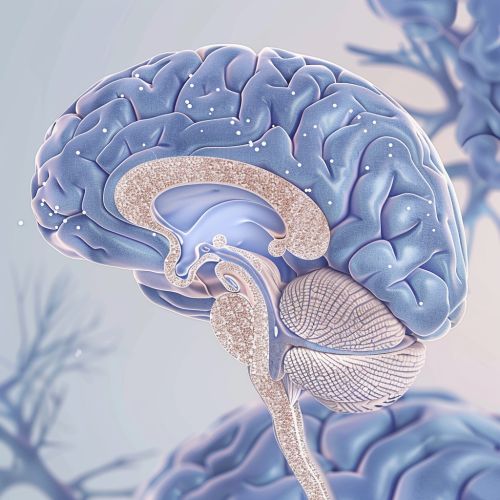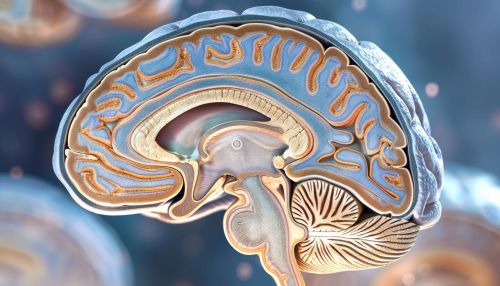Paleocortex: Difference between revisions
(Created page with "== Introduction == The paleocortex is a region of the brain that forms part of the cerebral cortex. It is an ancient structure, evolutionarily older than the neocortex, and is primarily involved in olfaction (the sense of smell) and certain aspects of memory and emotion. The paleocortex is characterized by its simpler, three-layered structure, in contrast to the six-layered neocortex. This article delves into the anatomy, function, and significance of the paleocortex...") |
No edit summary |
||
| Line 14: | Line 14: | ||
The polymorphic layer, also known as the deep layer, contains a mix of different cell types, including interneurons and glial cells. This layer is involved in modulating the activity of the pyramidal cells and integrating sensory information. | The polymorphic layer, also known as the deep layer, contains a mix of different cell types, including interneurons and glial cells. This layer is involved in modulating the activity of the pyramidal cells and integrating sensory information. | ||
[[Image:Detail-93289.jpg|thumb|center|Detailed illustration of the brain's structure, highlighting the paleocortex region.|class=only_on_mobile]] | |||
[[Image:Detail-93290.jpg|thumb|center|Detailed illustration of the brain's structure, highlighting the paleocortex region.|class=only_on_desktop]] | |||
== Function == | == Function == | ||
Latest revision as of 06:22, 22 June 2024
Introduction
The paleocortex is a region of the brain that forms part of the cerebral cortex. It is an ancient structure, evolutionarily older than the neocortex, and is primarily involved in olfaction (the sense of smell) and certain aspects of memory and emotion. The paleocortex is characterized by its simpler, three-layered structure, in contrast to the six-layered neocortex. This article delves into the anatomy, function, and significance of the paleocortex, providing a comprehensive and detailed exploration of this crucial brain region.
Anatomy
The paleocortex is located in the medial temporal lobe and is part of the archicortex, which also includes the hippocampus. It is primarily composed of the olfactory bulb, the olfactory tract, the piriform cortex, and parts of the amygdala. The paleocortex is distinguished by its three-layered structure, which includes the molecular layer, the pyramidal cell layer, and the polymorphic layer.
Molecular Layer
The molecular layer is the outermost layer of the paleocortex and contains a dense network of dendrites and axons. This layer is involved in the initial processing of olfactory information and serves as a site for synaptic integration.
Pyramidal Cell Layer
The pyramidal cell layer is the middle layer and contains the cell bodies of pyramidal neurons. These neurons are the primary excitatory cells in the paleocortex and play a crucial role in transmitting olfactory information to other brain regions.
Polymorphic Layer
The polymorphic layer, also known as the deep layer, contains a mix of different cell types, including interneurons and glial cells. This layer is involved in modulating the activity of the pyramidal cells and integrating sensory information.


Function
The primary function of the paleocortex is related to olfaction. It processes olfactory signals received from the olfactory bulb and relays this information to other brain regions, including the neocortex and the limbic system. The paleocortex is also involved in certain aspects of memory and emotion, particularly those related to olfactory stimuli.
Olfactory Processing
The paleocortex receives input from the olfactory bulb via the olfactory tract. This information is then processed in the piriform cortex, which is the main olfactory processing area within the paleocortex. The piriform cortex integrates olfactory signals and sends projections to various brain regions, including the orbitofrontal cortex, which is involved in the conscious perception of odors.
Memory and Emotion
The paleocortex has connections with the amygdala and the hippocampus, which are key regions involved in memory and emotion. Olfactory stimuli can evoke strong emotional responses and memories, a phenomenon often referred to as the "Proust effect." This is due to the direct connections between the olfactory system and the limbic system, mediated by the paleocortex.
Evolutionary Significance
The paleocortex is one of the oldest parts of the cerebral cortex, predating the development of the neocortex. It is present in all vertebrates, indicating its fundamental role in sensory processing and survival. The evolutionary significance of the paleocortex lies in its role in olfaction, which is a critical sense for many animals in finding food, detecting predators, and social communication.
Comparative Anatomy
In mammals, the paleocortex is relatively small compared to the neocortex, which has expanded significantly during evolution. However, in reptiles and amphibians, the paleocortex constitutes a larger portion of the cerebral cortex. This difference reflects the varying reliance on olfaction across different species.
Clinical Relevance
The paleocortex is implicated in various neurological and psychiatric conditions. Understanding its structure and function can provide insights into these disorders and potential therapeutic targets.
Epilepsy
The paleocortex, particularly the piriform cortex, is a known site of epileptogenic activity. Seizures originating in this region can spread to other parts of the brain, leading to complex partial seizures. Research into the mechanisms of epileptogenesis in the paleocortex is ongoing, with the aim of developing targeted treatments.
Neurodegenerative Diseases
Olfactory dysfunction is an early symptom in several neurodegenerative diseases, including Alzheimer's disease and Parkinson's disease. The paleocortex is one of the first regions to show pathological changes in these conditions, making it a potential biomarker for early diagnosis.
Psychiatric Disorders
The paleocortex's involvement in emotion and memory links it to various psychiatric disorders, such as anxiety disorders and depression. Abnormal olfactory processing and altered connectivity with the limbic system have been observed in these conditions, suggesting a role for the paleocortex in their pathophysiology.
Research and Future Directions
Ongoing research into the paleocortex aims to further elucidate its role in sensory processing, memory, and emotion. Advances in neuroimaging and electrophysiological techniques are providing new insights into the functional connectivity and dynamics of this ancient brain region.
Neuroimaging Studies
Modern neuroimaging techniques, such as functional MRI and positron emission tomography, are being used to study the paleocortex in vivo. These studies are revealing the intricate network of connections between the paleocortex and other brain regions, as well as its role in various cognitive and emotional processes.
Electrophysiological Research
Electrophysiological studies are providing detailed information about the neural activity within the paleocortex. Techniques such as intracranial EEG and optogenetics are being used to investigate the cellular and network mechanisms underlying olfactory processing and epileptogenesis.
Genetic and Molecular Approaches
Genetic and molecular approaches are being employed to study the development and function of the paleocortex. Research in this area is focused on identifying the genes and molecular pathways involved in the formation and maintenance of the paleocortex, as well as their role in neurological and psychiatric disorders.
See Also
- Neocortex
- Limbic system
- Olfactory bulb
- Piriform cortex
- Amygdala
- Hippocampus
- Epilepsy
- Alzheimer's disease
- Parkinson's disease
- Anxiety disorders
- Depression
